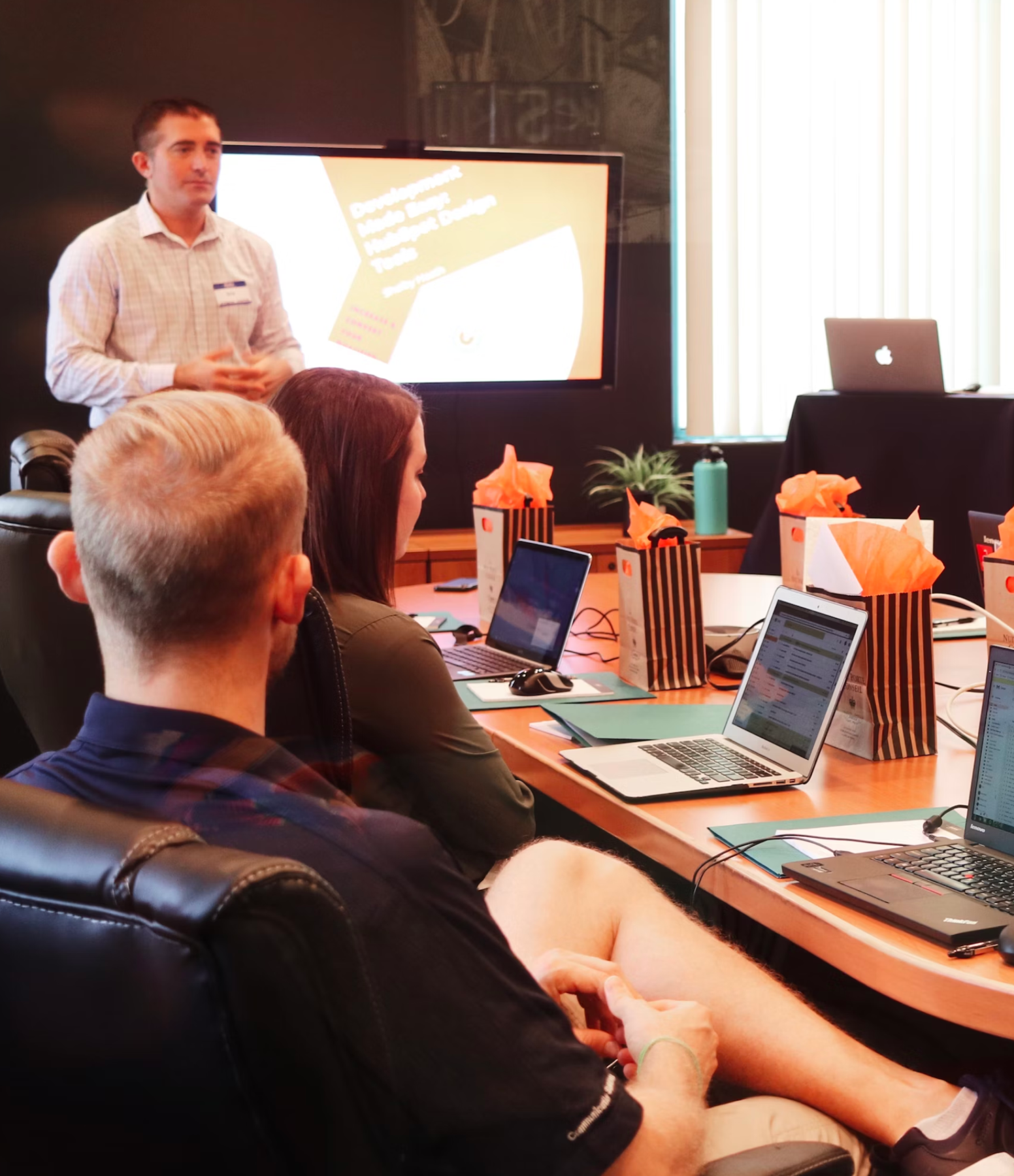Lean Six Sigma Black Belt (IASSC ™) Premium - eLearning (exam included)
1.350,00 EUR
- 36 hours
The Lean Six Sigma Black Belt Certification Training program is perfect for any quality management professionals who are looking to boost their careers and get their Six Sigma Black Belt Certification. This course has been aligned with the IASSC exam to ensure that this Lean Six Sigma Black Belt training equips you to handle complex projects while easily implementing Six Sigma methodologies. The Lean Six Sigma Black Belt training and certification course is designed to help you master the combined concepts of Lean and Six Sigma. This course will help you develop an in-depth understanding of the Six Sigma phases Define, Measure, Analyze, Improve, and Control (DMAIC) and how to maximize customer value while minimizing waste.
Course timeline

Define Phase
Session 01
The Basics of six Sigma
Lesson 01
- Introduction to define phase
- Learning Objectives
- Six Sigma
- Lean
- Sigma Shift
- Yield
- Continuous Improvement Process Evolution
- Six Sigma Deliverables
- Problem Solving Strategy
- VOC Campaign
- VOC Tools
- KANO Analysis
- Six Sigma Rotes and Responsibilities
- Project Champion and Master Black Belt
- Black Belt and Yellow Belt
- Drivers of Six Sigma
The Fundaments of Six Sigma
Lesson 02
- Process
- Project Charter
- Critical to quality
- Cost of Poor Quality
- Calculating CoPQ
- Pareto Analysis
- Basic six Sigma metrics
Selecting Lean Six Sigma Projects
Lesson 03
- Selecting Lean Six Sigma Projects
- Project Selection Roadmap
- Project Charter Elements
- Project Charter Business Case
- Project Charter Problem Statement
- Project Charter Goal Statement
- Project Charter Scope
- Project Charter Key Milestones
- Project Charter Team Selection
- Tuckman's Stages of Team Formation
- The RACI Matrix
- Expected Financial Benefits
- Developing Projects Metrics
- Key Performance Indicator
- Financial Evaluation and Benefits Capture
- Net Present Value
The Lean Enterprise
Lesson 04
- Selecting Lean Six Sigma projects
- Principles of Lean
- Lean Methodology
- Lean and Six Sigma
- 3M´s of Lean
- Categories of Waste: TIMWOOD
- Category of Waste: DOWNTIME
- 5S
- Steps in 5S
Measure Phase
Session 02
Process Definition
Lesson 01
- Introduction to measure phase
- Tools to Define a Process
- Cause and Effect Diagram
- Drawing a Fishbone Map
- Root Cause
- Process Mapping
- Creating a Process Map
- Process Mapping Levels
- Four Types of Process Maps
- SIPOC Process Map
- Value Streams Maps: Key Metrics
- X-Y Diagram of Scatterplots
- Failure Mode and Effects Analysis (FMEA)
- FMEA Process, FMEA Template
- Severity, Occurrence, and Detection Table
- Risk Priority Number (RPN)
Six Sigma Statistics
Lesson 02
- Data
- Measuring Data
- Basic Statistics
- Measures of Central Tendency
- Measures of Dispersion
- Data Collecting Plan
- Data Collection Methodology
- Develop a Measurement plan
- Collect Data
- Sampling Methods
- Graphical Analysis
- Graphical Analysis Tool
- Introduction to Minitab
- Demo: Boxplot one Variable
- Demo: Boxplot with three Variables
- Demo: Time series plot
- Normal Distribution: Standard Normal Distribution.
- Demo: Normality
Hypothesis Testing
Lesson 03
- Introduction
- Basics of Hypothesis Testing
- Confidence Interval
- Significant Difference
- Statistical Hypothesis Test
- Hypothesis Testing: Risks
- Beta Risk
- Power of a Hypothesis Test
- Sample Size
- Hypothesis Testing Roadmap
Hypothesis Testing with Normal Data
Lesson 04
- Introduction
- Normal Data
- One Sample t-test
- One Sample t-test Sample Size
- Demo: 1 Sample t Test
- Two-Sample t-Test
- Two-Sample t-Test Example
- Demo: 2 Sample t-Test
- Demo: Berlette #39:s Test
- Paired t-Test
- Demo: Paired Test
- ANOVA
- Demo: Anova
- Residual Plot
Hypothesis Testing with Non-Normal Data
Lesson 05
- Introduction
- Non Parametric Tests
- Mann-Whitney Tests
- Demo: Mann_Whitney_Test
- Kruskal-Wallis Test
- Demo: Kruskal_Walls_Test
- Mood´s Median Test
- Demo: Mood`s Median Test
- Friedman Test
- Demo: Freidman_Test
- 1 Sample Wilcoxon Test
- Demo: 1 Sample Wilcoxon Test
- One-Sample Proportion Test
- Demo: One-Sample proportion Test
- Two-Sample Proportion Test
- Demo: Two-Sample Proportion Test
- Chi-Square Tests
- Demo: Chi-square Goodness-of-fit Test,
- Chi-Square Goodness-of-Fit Test, Demo: Chi-Square Goodness-of-Fit Test.
- Chi-Square Cross Tabulation
- Demo: Chi-Square Cross Tabulation
- Demo: Levene_F-Test
Improve Phase
Session 03
Simple Linear Regression
Lesson 01
- Introduction to Improve Phase
- Learning Objectives
- Correlation, Demo: Correlation
- Demo: Scatterplot
- Correlation and Causation
- Predictor measures and Results
- Correlation Coefficients
- Regression Analysis, Demo: Regression
- Residual Analysis
Multiple Regression Analysis
Lesson 02
- Introduction
- Multi-Vari Analysis
- Demo: Multi-Vari Analysis
- Non-Linear Regression
- Multiple Linear Regression
- Demo: Multiple Linear Regression
- Variance inflation Factor (VIF)
- Variance inflation Factor (VIF): Example
- Confidence Interval in Multiple Linear Regression.
- Box-Cox Transformation
- Demo: Box-Cox Transformation
Designed Expriments
Lesson 03
- Introduction
- Designed Experiments
- Phases of DOE Process
- Optimization and confirmation
- Types of DOE Strategies
- Full Factorial and Factorial Approaches
- Experimental Design: Considerations.
Factorial Experiment's
Lesson 04
- Introduction
- Factorial Designs
- Full Factorial Experiments
- Demo: Full Factorial Experiments
- Quadratic Models
- Types of Response Surface Designs
- Balanced and Orthogonal Design
- Center Points
- Fractional Factorial Experiment
- Confounding
Control Phase
Session 04
Lean Controls
Lesson 01
- Introduction to Control Phase
- Learning Objectives
- Control Methods of 5S
- Sort
- Set in Order
- Shine standardize and sustain
- Kanban
- Kanban Principles
- Steps to implement Kanban
- Poka Yoke or Mistake Proofing
- Mistake Proofing Examples
Statistical Process Control (SPC)
Lesson 02
- Introduction
- Statistical Process Control: Purpose
- Control Charts
- Control Charts: Objectives
- Control Charts: Uses
- Control Charts: Types
- Control Charts: Steps
- Subgroup
- Consideration for Rational Subgrouping
- Charts for Attribute Data
- Tests for Special Causes
- Demo: I MR Chart
- Demo: X Bar R Chart
- Demo: X Bar s Chart
- Demo: P Charts
- Demo: NP Charts
- Demo: U Charts
- Demo: C Charts
- Demo: Cu sum Chart
- Demo: EWMA Chart
Six Sigma Control Plans
Lesson 03
- Introduction
- Project Cost Benefits Analysis
- Return on Investment (ROI)
- Cost Benefit Analysis
- Cost Benefit Analysis: Steps
- NPV and IRR
- Selecting the Right Solutions: Guidelines
- Implementation of Proposed Solutions: Roadmap.
- Control Plan
- Elements of a Control Plan
- Control Plan: Training
- Response Plan
- Project Closure
- Practice Projects
- V-tech Hydraulic Solutions
- Elite Elegance
Learning Outcomes
At the end of this Lean Six Sigma Black Belt (IASSC) eLearning Course, you will be able to:
Lean Concepts
Apply Lean concepts such as 5S, waste reduction, process mapping, value stream mapping, and mistake-proofing.
Relationship between Key Inputs & Process Outputs
Apply basic and more advanced statistical analyses to determine the relationship between key inputs and process outputs.
Team Dynamics
Effectively manage team dynamics and understand how to work with multiple levels of leadership to remove barriers and achieve project success.
Project Closing
Close projects and hand over control to process owners.
Project Presentation
Present projects to instructors, peers, and managers.
Key Features
9 Hours of online self-placed learning
36 Hours of Instructor led-training
4 Lean six Sigma Black Belt simulation exam
35 PDUs offered and six end-of-chapter quizzes
Two-course end Projects
Experiential learning through Case Studies
Course Completion Certificate

Who you should enroll this program?
Prerequisites:
There are no prerequisites required to sit for the IASSC Certified Lean Six Sigma Black Belt exam. Formal Lean Six Sigma training from a verified Lean Six Sigma trainer or corporate program is suggested if applicants want to increase their chances of passing the exam. It is also recommended that exam takers have some degree of real-world Lean Six Sigma work experience.
Senior Management
Team Leaders
Software Professionals
Project Managers
Quality Assurance Engineers
Software Quality Assurance Team Members
Managements Students

Need corporate solutions or LMS integration?
Didn't find the course or program which would work for your business? Need LMS integration? Write us, we will solve everything!
